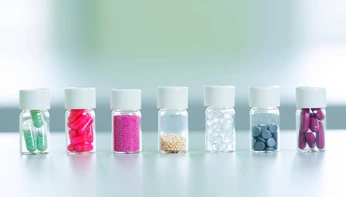
Are you missing out on the benefits of microparticles for solubility enhancement?
Spray-dried dispersion, hot-melt extrusion and solubilizing excipients are the most common techniques for solubility enhancement, but the pharmaceutical sector needs new innovations to maximize amorphous solid dispersion benefits. The very high number of new molecular entities which are poorly soluble, the dependency on formulation and process for pharmacokinetic performance and the inability of existing manufacturing technologies to overcome these hurdles are all potential barriers to successful drug delivery.
The increased use of oral microparticles offers a potential solution. Microparticles – which consist of the drug and polymer – have been widely studied for decades as an attractive formulation technology for controlled and extended drug release. They are mostly developed as parenteral formulation. After injection, microparticles continuously release the drug and maintain the drug level within the therapeutic window over time to provide long-term therapeutic effects.
The drug is encapsulated inside the polymer matrix. After administration, the polymer either dissolves or degrades in the human body, then the drug comes out from the microparticles.
There are several existing examples of commercial microparticle products, including for the alleviation of osteoarthritis pain and the palliative treatment of advanced prostate cancer. They usually come as a kit which includes the injection vehicle, the needle, and the microparticles. The microparticles are typically packaged in a vial or a prefilled syringe. They are re-suspended in the injection vehicle for administration. These products can have an extended-release over different periods, for example, formulations for one or two-weeks, one month, three months, or six months are available. The longest sustained release product currently on the market is 10 months.
Microencapsulation production technologies
There are three microencapsulation technologies used to make commercial microparticle products; solvent evaporation, solvent extraction and phase operation. Whichever technology you use, it is important to understand the polymer properties. These play a vital role in creating the matrix structure of microparticles which affects the uptake of water, which then penetrates into microparticles, finds the drug, dissolves the drug, and then releases it.

The internal structures of microparticles varies depending on the polymer and the drug properties and the process conditions. In some cases, the drug crystallizes during the microencapsulation process, particularly in products developed for extended release. In other cases, the drug is just dispersed in the polymer matrix.
For solubility enhancement and amorphous solid dispersion, we need to make sure that the drugs are molecularly dispersed in the microparticle matrix so that they have higher solubility for improved absorption.
Solvent extraction
At Evonik, we use a continuous solvent extraction process to produce microparticles. We combine the drug, the polymer, and the solvent to form a dispersed phase. We also have surfactant dissolved in water to form a continuous phase. When you prepare the dispersed phase, there are several factors to consider. For example, the solubility of the polymer, whether you dissolve the drug in the solvent, or just suspend the drug as particles in the polymer solution.
Other factors affecting your dispersed phase and microparticle preparation include the preparation method for a single or a double emulsion, and how the chemical stability of the drug in the dispersed phase is maintained.
The next stage is to take the dispersed phase and the continuous phase through the emulsion generator, where the emulsion droplets are formed. Then we move to solvent extraction. This is a really important step for making microparticles. We extract the solvent out of the emulsion droplets as soon as they emerge out of the emulsion generator.
There are several things happening at the same time during the solvent extraction. The solvent removal rate and the amount of solvent removal affect the polymer precipitation, then they affect the internal structure and also surface morphology of microparticles. For example, when we extract the solvent, the polymer is precipitated, and how they precipitate will define the internal structure of microparticles. Also, the drug can move across the emulsion surface when the solvent is being extracted out of the emulsion droplets. The properties of polymer and the drug, and also the process conditions will affect the microparticles.
There are different types of emulsion generators available for making microparticles, such as static mixer, rotor stator and Evonik-patented emulsion generators (FormEZE column and 416 workhead). Once you've started the flow in this equipment, you mix the dispersed phase with continuous phase and get the emulsion droplets. By using different emulsion generators and different process conditions, you can make microparticles of all different sizes. It is possible to create microparticles from 20 µm to 50 µm, which is very attractive for injectables. You can also make microparticles below 10 µm for uptake by macrophages and above 100 µm for oral applications. Depending on which application you are looking at, you can define the target microparticle size range that will fit the purpose.
Successful scale-up
A vital part of any drug development is the move from the laboratory to commercial scale manufacturing. Generally, it takes a significant amount of time to translate a successful research project to commercial products for microparticles. The major hurdles include scale-up of the process, and production according to ‘good manufacturing practices’ (GMP), as well as the regulatory evaluation due to the complexity of this type of formulation.

When you start your project at an early stage, you probably only need to make batches at a small scale of several grams. You can run your process just in your fume hood, and you can have several manual operations on your process. This gives you the flexibility to try different process concepts and troubleshoot very quickly.
When you move your project to a later stage development, like clinical and commercial manufacturing, the batch size is typically at kilogram scale, and you need to carry out GMP production to maximize the product safety and quality. The process also requires automated manufacturing, and the GMP production is much more rigid than the early-stage research because you cannot make changes to the formulation or process. Besides, it is important to consider the product's recovery to make sure you have an efficient production process for manufacturing.
We use both batch process and a continuous process to make microparticles. When we start a project, especially when the active pharmaceutical ingredient (API) quantity is very limited, we usually begin with batch process so that we can try different process concepts for a quick screening and a proof-of-concept study. When we move the project to further development, we like to transfer the batch process to continuous process as early as possible. Figure 3 shows that in the continuous process, you can have more control over the process conditions. When we start our process, the two flows will start and mix at the specific ratio we want.

For the continuous process, the start of the batch is the same as the end of the batch. The microparticles you make throughout the process remain homogeneous in their quality. For scale-up in a continuous process, you can just increase the tubing size and your equipment size to increase the flow rate of disperses. This continues proportionally, so that the time for making a batch stays substantially the same as you scale-up. Timing affects the properties of microparticles so this is important.
If you have a longer unit operation, the properties of the polymers, the drug, or the microparticles may change over time when you run your process. You would like to make sure you have good control on your process flow. If you have to use longer unit operation, or longer time processing, make sure that the time change won't affect the properties of microparticles.
Conclusion
Microparticles offer a potential extra avenue for successful solubility enhancement. However, when developing microparticles it is crucial to understand and control the critical material attributes and the critical process parameters because they play an important role in establishing microparticle properties.
This understanding is also significant as you scale-up. Formulation and process expertise is important for designing a microparticle formulation, scaling up, and commercialization. In summary, making microparticles and taking them to commercial manufacturing requires significant know-how.






